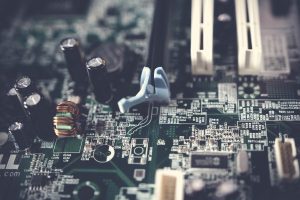

Rigid PCBs can not be bent or twisted because they incorporate an FR4 stiffener—a fire-resistant matrix of fiberglass and epoxy—to increase rigidity.
Rigid PCBs have a number of uses. A computer motherboard is one such application; toys, LED lights, automotive dashboards, vending machines, desktop devices, HVAC systems, GPS technologies and solid state devices are also places you’ll likely encounter rigid PCBs.
Single-sided rigid PCBs are ideal because they are simple and easy to manufacture. They are well-suited for rapid production requirements.
Double-sided rigid PCBs are an industry standard. They are very similar to single-sided rigid PCBs, except that they have copper traces on both sides. The circuits on one side of the board connect to circuits on the other side using through-hole technology and/or surface-mount technology.
Multilayer PCBs have more than two conductive layers, each separated by insulation. These boards allow for complex designs. The extra layers can help prevent electromagnetic interference generated from the device.
To get started with your rigid PCB project, contact Via Technology today!